|
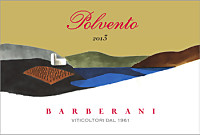
|
Lago di Corbara Rosso Polvento 2013 |
| Barberani (Umbria, Italy) |
 Sangiovese Grosso Sangiovese Grosso |
| Price: € 36.00 |
Score:      |
 Intense ruby red and nuances of garnet red, little transparency.  Intense, clean, pleasing, refined and elegant, start with hints of
black cherry, plum and dried violet followed by aromas of blueberry,
raspberry, pink pepper, tobacco, vanilla, chocolate, cinnamon, mace and
menthol.
 Properly tannic attack and however balanced by alcohol, full body,
intense flavors, pleasing roundness.
 Persistent finish with flavors of black cherry, plum and blueberry.  24 months in barrique, 2 years in bottle. |
 Game, Roasted meat, Stewed and braised meat, Hard cheese Game, Roasted meat, Stewed and braised meat, Hard cheese |
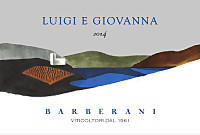
|
Orvieto Classico Superiore Luigi e Giovanna 2014 |
| Barberani (Umbria, Italy) |
 Grechetto (90%), Trebbiano Procanico (10%) Grechetto (90%), Trebbiano Procanico (10%) |
| Price: € 36.00 |
Score:      |
 Brilliant golden yellow and nuances of straw yellow, very transparent.  Intense, clean, pleasing, refined and elegant, starts with hints of
apple, plum and apricot followed by aromas of hawthorn, citrus fruits,
hazelnut, peach, pear, medlar, almond, honey, broom, mineral and hints of
vanilla.
 Crisp attack and however balanced by alcohol, good body, intense
flavors, pleasing roundness.
 Very persistent finish with long flavors of apple, apricot and peach.  6 months in cask, 12 months in bottle. |
 Stuffed pasta, Roasted white meat, Roasted fish, Mushroom soups Stuffed pasta, Roasted white meat, Roasted fish, Mushroom soups |
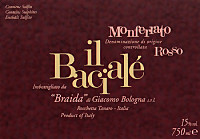
|
Monferrato Rosso Il Bacialè 2015 |
| Braida (Piedmont, Italy) |
 Barbera (60%), Pinot Nero (20%), Cabernet Sauvignon (10%), Merlot (10%) Barbera (60%), Pinot Nero (20%), Cabernet Sauvignon (10%), Merlot (10%) |
| Price: € 13.00 |
Score:     |
 Intense ruby red and nuances of ruby red, little transparency.  Intense, clean, pleasing and refined, starts with hints of black
cherry, black currant and blueberry followed by aromas of violet, plum,
blackberry, raspberry, vanilla, cinnamon and menthol.
 Properly tannic attack and however balanced by alcohol, good body,
intense flavors, pleasing crispness.
 Persistent finish with flavors of cherry, plum and black currant.  12 months in cask and barrique, 4 months in bottle. |
 Broiled meat and barbecue, Stewed meat with mushrooms, Cheese Broiled meat and barbecue, Stewed meat with mushrooms, Cheese |
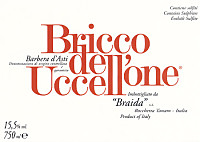
|
Barbera d'Asti Bricco dell'Uccellone 2015 |
| Braida (Piedmont, Italy) |
 Barbera Barbera |
| Price: € 49.00 |
Score:      |
 Intense ruby red and nuances of ruby red, little transparency.  Intense, clean, pleasing, refined and elegant, starts with hints of
cherry, plum and violet followed by aromas of raspberry, blueberry,
blackberry, vanilla, tobacco, cinnamon, rhubarb, chocolate, face powder,
licorice, graphite, mace and menthol.
 Properly tannic attack and however balanced by alcohol, full body,
intense flavors, pleasing crispness.
 Very persistent finish with long flavors of cherry, plum and blueberry.  15 months in barrique, 12 months in bottle. |
 Game, Roasted meat, Stewed and braised meat, Hard cheese Game, Roasted meat, Stewed and braised meat, Hard cheese |
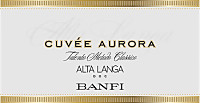
|
Alta Langa Brut Cuvée Aurora 2012 |
| Castello Banfi (Piedmont, Italy) |
 Pinot Nero (70%), Chardonnay (30%) Pinot Nero (70%), Chardonnay (30%) |
| Price: € 18.00 |
Score:     |
 Brilliant straw yellow and nuances of straw yellow, very transparent,
fine and persistent perlage.
 Intense, clean, pleasing and refined, starts with hints of banana,
citrus fruits and bread crust followed by aromas of acacia, plum, apple,
butter, pear, yeast, honey and hints of vanilla.
 Effervescent and crisp attack, however balanced by alcohol, good body,
intense flavors, agreeable.
 Persistent finish with flavors of banana, apple and plum.  Part of the base wine is aged in barrique. Refermented and aged in
bottle on its lees for at least 30 months.
|
 Fried fish, Pasta and risotto with crustaceans and fish, Sauteed fish, Dairy products Fried fish, Pasta and risotto with crustaceans and fish, Sauteed fish, Dairy products |
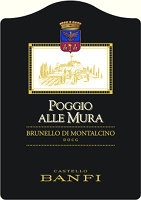
|
Brunello di Montalcino Poggio alle Mura 2012 |
| Castello Banfi (Tuscany, Italy) |
 Sangiovese Sangiovese |
| Price: € 43.00 |
Score:      |
 Brilliant ruby red and nuances of garnet red, moderate transparency.  Intense, clean, pleasing, refined and elegant, starts with hints of
black cherry, plum and dried violet followed by aromas of raspberry,
blueberry, blackberry, tobacco, chocolate, cinnamon, licorice, vanilla,
leather, mace and menthol.
 Tannic attack and however balanced by alcohol, full body, intense
flavors, pleasing crispness.
 Persistent finish with flavors of black cherry, plum and raspberry.  24 months in barrique and cask, 12 months in bottle. |
 Game, Roasted meat, Stewed and braised meat, Hard cheese Game, Roasted meat, Stewed and braised meat, Hard cheese |
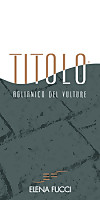
|
Aglianico del Vulture Titolo 2015 |
| Elena Fucci (Basilicata, Italy) |
 Aglianico Aglianico |
| Price: € 30.00 |
Score:      |
 Intense ruby red and nuances of ruby red, little transparency.  Intense, clean, pleasing, refined and elegant, starts with hints of
blackberry, black cherry and plum followed by aromas of violet, raspberry,
blueberry, geranium, chocolate, vanilla, tobacco, pink pepper, rosemary,
cinnamon and menthol.
 Tannic attack and however balanced by alcohol, full body, intense
flavors, pleasing crispness.
 Very persistent finish with long flavors of blackberry, black cherry
and plum.
 12 months in barrique, 12 months in bottle. |
 Game, Roasted meat, Stewed and braised meat, Hard cheese Game, Roasted meat, Stewed and braised meat, Hard cheese |
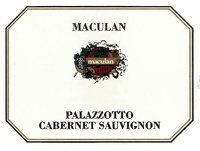
|
Breganze Cabernet Sauvignon Palazzotto 2014 |
| Maculan (Veneto, Italy) |
 Cabernet Sauvignon Cabernet Sauvignon |
| Price: € 20.20 |
Score:     |
 Intense ruby red and nuances of ruby red, little transparency.  Intense, clean, pleasing and refined, starts with hints of black
currant, black cherry and plum followed by aromas of violet, blueberry,
vanilla, cocoa, tobacco, mace and eucalyptus.
 Properly tannic attack and however balanced by alcohol, good body,
intense flavors, agreeable.
 Persistent finish with flavors of black currant, black cherry and plum.  12 months in barrique. |
 Roasted meat, Broiled meat and barbecue, Stewed and braised meat with mushrooms, Cheese Roasted meat, Broiled meat and barbecue, Stewed and braised meat with mushrooms, Cheese |
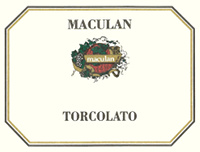
|
Breganze Torcolato 2012 |
| Maculan (Veneto, Italy) |
 Vespaiola Vespaiola |
| Price: € 35.10 |
Score:      |
 Brilliant amber yellow and nuances of amber yellow, transparent.  Intense, clean, pleasing, refined and elegant, starts with hints of
raisin, dried apricot and honey followed by aromas of candied fruits, dried
fig, citrus fruit peel, quince jam, pear jam, date, almond, butter and
vanilla.
 Sweet and round attack, however balanced by alcohol, good body, intense
flavors, pleasing crispness.
 Persistent finish with flavors of raisin, dried apricot and dried fig.  12 months in barrique. |
 Confectionery, Jam tarts, Piquant cheese Confectionery, Jam tarts, Piquant cheese |
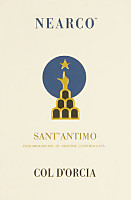
|
Sant'Antimo Rosso Nearco 2014 |
| Col d'Orcia (Tuscany, Italy) |
 Merlot (50%), Cabernet Sauvignon (30%), Syrah (15%), Petit Verdot (5%) Merlot (50%), Cabernet Sauvignon (30%), Syrah (15%), Petit Verdot (5%) |
| Price: € 20.00 |
Score:     |
 Intense ruby red and nuances of ruby red, little transparency.  Intense, clean, pleasing and refined, starts with hints of black
currant, black cherry and blueberry followed by aromas of violet, plum,
chocolate, black pepper, mace, tobacco, vanilla and eucalyptus.
 Properly tannic attack and however balanced by alcohol, good body,
intense flavors, pleasing roundness.
 Persistent finish with flavors of black currant, black cherry and
blueberry.
 12 months in barrique and cask. |
 Roasted meat, Broiled meat and barbecue, Stewed meat with mushrooms, Hard cheese Roasted meat, Broiled meat and barbecue, Stewed meat with mushrooms, Hard cheese |
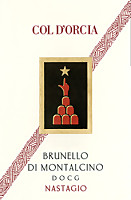
|
Brunello di Montalcino Poggio alle Mura 2012 |
| Castello Banfi (Tuscany, Italy) |
 Sangiovese Sangiovese |
| Price: € 45.00 |
Score:      |
 Brilliant ruby red and nuances of garnet red, moderate transparency.  Intense, clean, pleasing, refined and elegant, starts with hints of
black cherry, plum and dried violet followed by aromas of raspberry,
blueberry, blackberry, tobacco, chocolate, cinnamon, licorice, vanilla,
leather, mace and menthol.
 Tannic attack and however balanced by alcohol, full body, intense
flavors, pleasing crispness.
 Persistent finish with flavors of black cherry, plum and raspberry.  24 months in barrique and cask, 12 months in bottle. |
 Game, Roasted meat, Stewed and braised meat, Hard cheese Game, Roasted meat, Stewed and braised meat, Hard cheese |
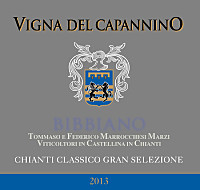
|
Chianti Classico Gran Selezione Vigna del Capannino 2013 |
| Bibbiano (Tuscany, Italy) |
 Sangiovese Grosso Sangiovese Grosso |
| Price: € 28.00 |
Score:      |
 Intense ruby red and nuances of garnet red, little transparency.  Intense, clean, pleasing, refined and elegant, starts with hints of
black cherry, plum and violet followed by aromas of blueberry, blackberry,
raspberry, strawberry, rose, face powder, tobacco, cocoa, cinnamon, mace,
vanilla and menthol.
 Properly tannic attack and however balanced by alcohol, good body,
intense flavors, agreeable.
 Persistent finish with flavors of black cherry, plum and raspberry.  24 months in cask. |
 Roasted meat, Stewed and braised meat, Broiled meat and barbecue, Hard cheese Roasted meat, Stewed and braised meat, Broiled meat and barbecue, Hard cheese |
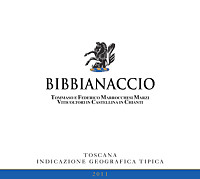
|
Bibbianaccio 2011 |
| Bibbiano (Tuscany, Italy) |
 Sangiovese (50%), Colorino (44%), Trebbiano Toscano, Malvasia Bianca (6%) Sangiovese (50%), Colorino (44%), Trebbiano Toscano, Malvasia Bianca (6%) |
| Price: € 64.00 |
Score:      |
 Brilliant ruby red and nuances of garnet red, little transparency.  Intense, clean, pleasing, refined and elegant, starts with hints of
plum, black cherry and dried violet followed by aromas of blueberry,
blackberry, cocoa, tobacco, cinnamon, licorice, mace, thyme, leather,
vanilla and menthol.
 Properly tannic attack and however balanced by alcohol, full body,
intense flavors, pleasing roundness.
 Very persistent finish with long flavors of black cherry, plum and
blackberry.
 24 months in cask, 6 months in bottle. |
 Game, Roasted meat, Stewed and braised meat, Hard cheese Game, Roasted meat, Stewed and braised meat, Hard cheese |
|



